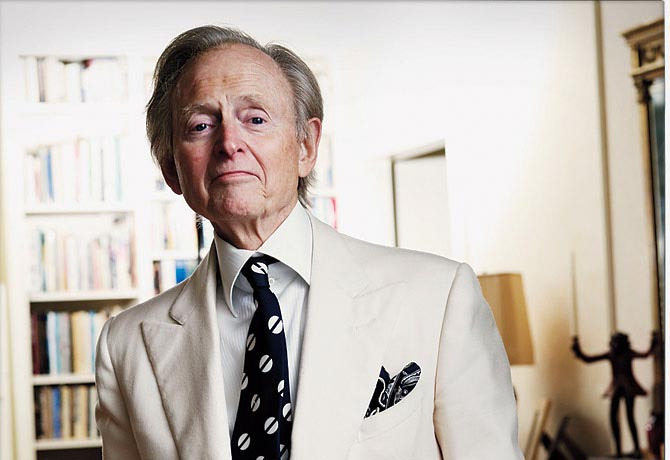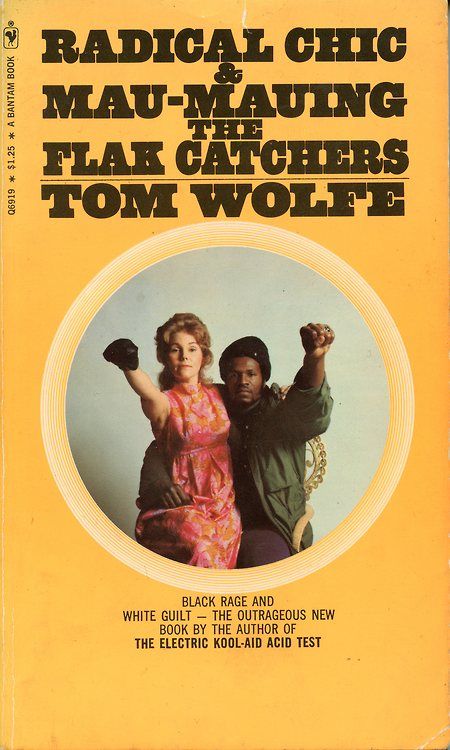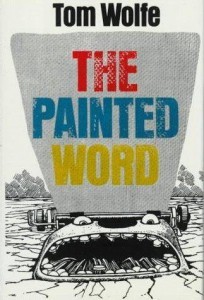Is Tom Wolfe a Race Realist? Part 1 of 3

Tom Wolfe
Perhaps it is a product of his Southern heritage — born in Richmond in 1931, B.A. Washington and Lee, 1951. Perhaps it is due to his academic training, Ph.D. in American studies from Yale, 1957, completed before the neo-Marxist hegemony over the humanities and social sciences. Perhaps it is a result of his years as a reporter developing the New Journalism that seeks to tell the larger story. But most likely it is a consequence of his dedication to social realism that has led Tom Wolfe to become the closest thing we have to a mainstream race-realist author.
What is race realism? Ideological labels are often difficult to delineate precisely, but generally a race realist is one who acknowledges the physical reality of race and the significance of human biodiversity in the development of past and present human societies.
This is in contrast to the establishment’s position that insists upon the primacy of the individual while minimizing the importance of race. Races are not naturally occurring phenomena, but merely social constructs grouped around, perhaps, a few superficial physical characteristics. Yet, the inclusion of and advocacy for multiple “social constructs” within White homelands has become a social/political obsession and the basis for the civic religion of the West.
Race realists can also be distinguished from their more radical cousins, racial nationalists, by their embrace of conservatism grounded in patriotism (e.g., American exceptionalism), Christianity, and/or libertarianism. The nationalists are less enamored of Christianity and capitalism, and paradoxically, tend toward internationalism (“our race is our nation”) while advocating for homogeneous ethno-states. Race realists are not separatists, believing instead that a vigorous pursuit of identity politics within a multiracial state is enough to safeguard their people’s interests.
At 82 Wolfe has been writing for over half a century so he has a very lengthy bibliography. By looking at some representative writings we can see if Wolfe fits the race realist mold. Here I will discuss six nonfictions books: Radical Chic and Mau-Mauing the Flak Catchers (1970), The Painted Word (1975), The Right Stuff (1979), Mauve Gloves & Madmen, Clutter & Vine (1976), From Bauhaus to Our House (1981), and Hooking Up (2000); plus three novels: Bonfire of the Vanities (1987), A Man in Full (1998), and Back to Blood (2012).[1] Because Wolfe spent the first 30 years of his career as a journalist and social commentator, we will first consider his nonfiction works in thematic rather than chronological order.
One measure of a writer is his influence on language. William Shakespeare is the gold standard for effect on common usage. While no Shakespeare, Wolfe has coined or popularized a number of terms: “the me decade,” later morphed into “the me generation” (i.e. baby boomers), having the “right stuff,” “pushing the envelope,” being a “good ol’ boy,” ‘mau-mau’ or ‘mau-mauing’ used as verbs, and “radical chic.”
 Written at the height of the Black Power movement Radical Chic begins by describing a February 1970 fund-raising party given by Leonard and Felicia Bernstein for the Black Panther Party at their Park Avenue penthouse. The Bernsteins’ party was not a unique event within their circle. Wolfe notes that Sid Lumet, Andrew Stein, Jules Feiffer, and Ellie Guggenheimer, among others, had previously given fund-raisers for radical causes.
Written at the height of the Black Power movement Radical Chic begins by describing a February 1970 fund-raising party given by Leonard and Felicia Bernstein for the Black Panther Party at their Park Avenue penthouse. The Bernsteins’ party was not a unique event within their circle. Wolfe notes that Sid Lumet, Andrew Stein, Jules Feiffer, and Ellie Guggenheimer, among others, had previously given fund-raisers for radical causes.
This brings up the issue of Wolfe’s relationship to Jews. It appears he has ambivalent feelings about them in keeping with a race realist perspective. Whether it is radical chic politics, modern art, or contemporary literature Wolfe dislikes many Jewish creations. The Virginian, born and bred, however, is a long-time resident of New York and has been part of the city’s culturati for decades. His wife Sheila is described as, “smart and attractive, but… a tough Jewish girl from the Bronx.”[2] Well, several men in the race realist cause have non-White spouses. And while Wolfe is willing to discuss Jewish influence explicitly in a somewhat negative context, he also maintains a rather detached view regarding their injurious influences. So Wolfe makes the Jewish connection to radical chic explicit, but sees nothing really malicious about Jews embracing radical causes.
Wolfe concedes there is an element of Jewish resentment toward the older establishment, but not just “out of resentment, but also for sheer self defense, even wealthy Jews tended to support left-wing political parties. They had no choice.”[3] Wolfe suggests that it was not until the 1960s that the Jewish, “New Society,” became New York’s social elite. This is a later date than many social historians would give. He notes the influence Jews have on the press through advertising revenue; again this was a decades-old phenomenon even in 1970.
The biggest fault Wolfe finds with the Bernsteins and their crowd is hypocrisy. Their concern for the poor is somewhat selective — poor non-Whites, yes; poor Whites, not so much — and they are determined to maintain their own wealth, power, and status come what may.
As for the Panthers, although there is an element of the poseur, Wolfe believes them to be true revolutionaries. They are physically imposing, but not very articulate. In another book he describes them as one of those “exotic impossible causes.”[4]
The Bernsteins took some heat for their party, some from the establishment, but mostly from their own tribe. Leonard received death threats from the Jewish Defense League and “Jewish pickets forced a moviehouse to withdraw a film of Lenny conducting the Israel Philharmonic on Mount Scopus in celebration of Israel’s victory in the Six-Day War.”[5] It should be remembered that it had been only a few years earlier that Black Power advocates had wrestled control of the civil rights movement from Jewish hands and the Panthers, of course, supported the Arabs in Palestine.
To conclude Wolfe’s take on radical chic: Is it possible that the highly intelligent Wolfe is a bit naïve to ascribe Jewish radicalism to misguided altruism, plus self-defense? Does the familial connection slant his views? He refers to Jewish influence but not outright ownership of mass media. He does discuss the “double-track thinking” of Jews. Does this term include Jewish self deception regarding their objectivity? The core compliant of many non-Jews against organized Jewry is their double standard that promotes ethnic solidarity for Jews while promoting multiculturalism for the wider society. It is this subjectivity that makes what is best for Jews the measure of morality, thus squaring the circle.
The second half of this book is about mau-mauing — the confrontation and intimidation of persons in authority by non-Whites in order to obtain favorable government or corporate action, especially financial largesse. Mau-mauing includes demonstrations, so called street theater, confrontations at government or corporate meetings, even rioting. Sometimes not-so-veiled threats (e.g., “it could be a long hot summer,” or “no justice, no peace”) are enough to achieve the desired results.
Much has changed since the 1960s and 1970s. Most funding once gained through mau-mauing has now been institutionalized and bureaucratized. The ethnic activists have largely been co-opted by the system. Today mau-mauing mainly involves intersession with the criminal justice system on behalf of street Blacks such as Rodney King and Treyvon Martin.
Reporting from the Bay area in the late 1960s Wolfe notes that mau-mauing originated with Blacks and then spread to Chicanos, Filipinos, Amerindians, even Samoans, but not the Chinese. “They didn’t fear or resent white people enough. They looked down on whites as childish and uncultivated. They also found it somewhat shameful to present themselves as poor and oppressed on the same level with Negroes and Mexican-Americans.”[6] Wolfe adds that seeing how things were playing out, the Chinese did eventually adopt racial politics.
Viewing the Panthers and other mau-mauers from the perspective of forty plus years we can see why even so called conservatives got onboard with “civil rights,” affirmative action, and ethnically based welfare programs. These were considered, in part, to be necessary payoffs for social peace and the stability of the system. An early case in point is the Blackstone Rangers, a notorious Chicago street gang of the late 1960s. In 1968 the Rangers received a grant worth nearly a million dollars from the federal Office of Economic Opportunity, real money in those days, “The Ranger leaders became job counsels in the manpower training project, even though most of them never had a job before and weren’t about to be looking for one. This wasn’t a case of the Blackstone Rangers putting some huge prank over on the poverty bureaucrats, however.”[7] No, it was a very deliberate strategy to bring the gangs into the system.
Since 1968 the establishment has come to realize that there simply are not enough resources to buy off every “gangsta.” Law and order is the other side of the civil rights coin. So for those who are simply unwilling or unable to take advantage of affirmative action, ethnic set asides, and other social programs, the U.S. has the longest prison sentences and proportionally largest prison population in the world. It is on this margin where the last of the old mau-mauers such as “the Reverend” Al Sharpton and the young thugs of the New Black Panther Party operate.
 In The Painted Word Wolfe shifts gears from social commentator to art critic. He implies that modern art is similar to the emperor’s new clothes — “believing is seeing.”[8] The viewer must accept the underlying aesthetic theory of the piece to understand and appreciate the work. But it is not simply that modern art is a con game or aesthetically unsatisfying and shallow. The visual arts have become socially destructive.
In The Painted Word Wolfe shifts gears from social commentator to art critic. He implies that modern art is similar to the emperor’s new clothes — “believing is seeing.”[8] The viewer must accept the underlying aesthetic theory of the piece to understand and appreciate the work. But it is not simply that modern art is a con game or aesthetically unsatisfying and shallow. The visual arts have become socially destructive.
Wolfe never explicitly defines modern art, but nineteenth-century Impressionists do not come in for criticism. It appears modernism begins with abstract art of the early twentieth century. Modern art grew out of the artist in the role of bohemian or revolutionary. By 1900, and especially after 1920, the task of the artist was to undermine the popular aesthetic of society. “As a painter or sculptor the artist would do work that baffled or subverted the cozy bourgeois vision of reality.”[9]
Though often produced and promoted by Jews, modern art was brought to the United States in the 1920s by the Rockefellers and Goodyears, in part, as a way of separating themselves from middle-class tastes. There was some resistance. In 1923 conservative art critic Royal Cortissoz “compared the alien invasion of European modernism to the subversive alien hordes coming in by boat. ‘Ellis Island art,’ he called it.”[10]
Realizing that modernism was alienating the masses and seeing a threat from the populist Right, the Left transformed art during the 1930s. Striking evidence of the link between modern art and left-wing politics is shown in the rise of a new genre — Social Realism. “Translation: propaganda paintings. The influence of Left politics was so strong within the art world during the 1930s that Social Realism became not a style of the period but the style of the period”[11] (emphasis in original).
It was after World War II, after the challenge of the revolutionary Right had been crushed, that modernism in the form of Abstract Expressionism sought a mass audience. Wolfe explains that much more than in literature, music, or drama, taste in the visual arts is a top-down phenomenon with a cultural elite pronouncing judgment on artists’ works. This permits a small coterie of critics to dominate the art world. The two dominant art theorists and aestheticians of the late 1940s and 50s were Clement Greenberg and Harold Rosenberg. Both were Jewish New Yorkers involved in left-wing politics during the 1930s who became promoters of Abstract Expressionism. Abstract Expressionism, described by Wolfe as “an abstraction of an abstraction” generally received good press. Favorable articles appeared in Life, Time and Newsweek.[12] Yet the genre was not a commercial success.
The next movement within modernism was Pop Art. Originating in 1958 with works by Jasper Johns and Robert Rauschenberg, it was popularized by Leo Steinberg, a professor of Hunter College along with art theorist and collector William Rubin, also Jews. Wolfe sees Pop Art as a way of overcoming popular resistance to a lack of realism in modern art. “Steinberg, Rubin and [Lawrence] Alloway had declared Pop Art kosher and quite okay to consume, because it was all ‘sign systems,’ not realism.”[13]
Wolfe goes on to chronicle several other Modernist movements: Minimal Art, Op Art, Conceptual Art, Photo Realism, but the point has been made. Modern art is not just bad art, it is alienating nihilistic art, and Jews have taken the lead in promoting this art, especially in postwar America. Wolfe quotes critic Steinberg as saying that the public should “applaud the destruction of values” brought about by modernism.[14]
It would have been useful for Wolfe to put his critique into a wider context and give his own aesthetic theory. Why is art so important to society? Is a civilization judged by its aesthetic values? Does he believe, along with Keats, that, “Beauty is truth, truth beauty”?
So plainly Wolfe does connect Jews and left-wing politics to modern art. For many years William Pierce included Painted Word in his book catalog. The catalog description reads, in part, “You don’t understand modern ‘art’? Social commentator Tom Wolfe does, and he isn’t impressed. He exposes it for the monstrous, alien-inspired, culture-destroying racket that it is.”[15] The art scene has not improved since the publication of Painted Word. Witness such uplifting works as Serrano’s Piss Christ.
[1] Tom Wolfe, Radical Chic and Mau-Mauing the Flak Catchers (New York: Farrar, Straus and Giroux, 1970).
Tom Wolfe, The Painted Word (New York: Farrar, Straus and Giroux, 1975).
Tom Wolfe, Mauve Gloves & Madmen, Clutter & Vine (New York: Farrar, Straus and Giroux, 1976).
Tom Wolfe, The Right Stuff (New York: Farrar, Straus and Giroux, 1979).
Tom Wolfe, From Bauhaus to Our House (New York: Farrar, Straus and Giroux, 1981).
Tom Wolfe, Hooking Up (New York: Farrar, Straus and Giroux, 2000).
Tom Wolfe, The Bonfire of the Vanities (New York: Farrar, Straus and Giroux, 1987).
Tom Wolfe, A Man in Full (New York: Farrar, Straus and Giroux, 1998).
Tom Wolfe, Back to Blood (New York: Little, Brown & Company, 2012).
[2] Charles McGrath, “Wolfe’s World,” The New York Times Magazine, October 31, 2004, 37.
[3] Wolfe, Radical Chic, 38.
[4] Wolfe, Mauve Gloves, 120.
[5] Wolfe, Radical Chic, 90.
[6] Ibid., 106.
[7] Ibid., 140.
[8] Wolfe, Painted Word, 7.
[9] Ibid., 15.
[10] Ibid., 38.
[11] Ibid., 41.
[12] Ibid., 68.
[13] Ibid., 89.
[14] Ibid., 91.
[15] The Painted Word, National Vanguard Books Catalog # 18. November 1998, 23.





Comments are closed.